Introduction
In South America use of wildlife as food or gifts is deeply embedded in traditional rural lifestyles. An estimated 5–8 million people throughout the continent are thought to consume bushmeat regularly, as a source of protein, fat and micronutrients (Sirén & Machoa, Reference Sirén and Machoa2008; Golden et al., Reference Golden, Fernald, Brashares, Rasolofoniaina and Kremen2011), and most of those who rely on bushmeat are among the poorest in the region (Rushton et al., Reference Rushton, Viscarra, Viscarra, Basset, Baptista and Brown2005). In some cases bushmeat is also eaten as a festival food or because people prefer it over domestic meat (Wilkie & Godoy, Reference Wilkie and Godoy2001; Sirén, Reference Sirén2012). The bushmeat trade is an important part of local economies, contributing to livelihoods, food security and dietary diversity (Sirén, Reference Sirén2012; Parry et al., Reference Parry, Barlow and Pereira2014; van Vliet et al., Reference van Vliet, Quiceno-Mesa, Cruz-Antia, Neves de Aquino, Moreno and Nasi2014). In most South American countries trading of bushmeat can be conducted legally under licenses issued by local authorities (van Vliet et al., Reference van Vliet, Gomez, Quiceno-Mesa, Escobar, Andrade and Nasi2015b); however, because administrative procedures to obtain a permit are often unclear or complex, most of the bushmeat trade is carried out illegally.
Data on bushmeat sold in South American towns are largely derived from confiscations by environmental agencies (OTCA, 2009), and therefore may underestimate the situation. Some information exists on the extent of urban bushmeat markets in Iquitos in Peru (Rushton et al., Reference Rushton, Viscarra, Viscarra, Basset, Baptista and Brown2005), Pompeya in Ecuador (WCS, 2007) and Abaetetuba in Brazil (Baía et al., Reference Baía, Guimarães and Le Pendu2010). Parry et al. (Reference Parry, Barlow and Pereira2014) examined the scale and drivers of urban consumption of wildlife in the forested pre-frontier of Brazilian Amazonia and found that almost half of the urban households surveyed consumed bushmeat at least once per month. In a study of the species and volume of bushmeat sold in the trifrontier (Brazil–Peru–Colombia) Amazonian towns of Leticia, Tabatinga and Caballococha, van Vliet et al. (Reference van Vliet, Quiceno-Mesa, Cruz-Antia, Neves de Aquino, Moreno and Nasi2014) showed that an estimated 473 t of bushmeat was potentially traded per year. Given the size of the urban population of this region it is likely that 3.2 kg per capita per year is consumed there, which is comparable to the estimated consumption for urban areas in Central Africa, where bushmeat consumption is commonplace (Nasi et al., Reference Nasi, Taber and van Vliet2011).
The literature on bushmeat trade in South America has focused primarily on the Amazon region, probably because the bushmeat trade in other ecosystems, such as tropical dry forests, mountain forests or savannahs, is thought to be insignificant and largely absent because of the greater availability of alternative sources of protein (e.g. beef, chicken, fish; Rushton et al., Reference Rushton, Viscarra, Viscarra, Basset, Baptista and Brown2005). It is estimated that only c. 1.5–2.0% of the total population in South America consume bushmeat regularly (Rushton et al., Reference Rushton, Viscarra, Viscarra, Basset, Baptista and Brown2005), and bushmeat consumption is considered to be absent in urban areas.
A number of studies have highlighted the importance of wildlife in various regions in Colombia (see Vargas-Tovar, Reference Vargas-Tovar and Restrepo2012, for a review). Despite the existence of sanctions (including imprisonment), commercial hunting is a regular occurrence within rural communities there; for example, an estimated 43% of animals taken by hunters in Puerto Nariño (an Amazon region on the border with Peru) were sold to consumers (Quiceno et al., Reference Quiceno, Cruz-Antia, Moreno, van Vliet, Trujillo and Duque2014). The majority of species traded were mammals (60% of reports), followed by birds (26%) and reptiles (14%). Hunting was carried out essentially for subsistence, as a direct source of food or as a means of generating income to purchase commercially available foodstuffs and beverages, processed products, or hunting supplies. In Inírida (Colombian Amazonas bordering Venezuela) 31–53% of hunter offtake was sold (Ortega, Reference Ortega2014). In the Andes region, however, commercial hunting in Boyacá was found to be relatively insignificant (Casas-Ramírez, Reference Casas-Ramírez2007) but sometimes rodents and birds were sold to meet shortfalls in agricultural production.
Countrywide data on bushmeat trade in Colombia are available from official sources. Data from the Department of Security indicate that as much as 31,147 kg of bushmeat was confiscated during 1998–2004 (Mancera & Reyes, Reference Mancera and Reyes2008), and data from the Direction of Taxes and Customs show that c. 12,621 kg of capybara meat Hydrochoerus hydrochaeris was seized during 2004–2006 (Mancera & Reyes, Reference Mancera and Reyes2008). These data are presumed to significantly underestimate the amounts traded, as seizures probably account for only 1–10% of the volume of wild meat commercialized (Mancera & Reyes, Reference Mancera and Reyes2008). There is therefore a need to understand better which species are commercialized for meat, what bushmeat trade chains exist, and the trade routes and stakeholders involved, to identify ways of making bushmeat trade sustainable without threatening Colombia's biodiversity.
We investigated wild meat markets in a number of contrasting environments in Colombia, in 24 urban municipalities within the country's five main ecoregions. We aimed to document the wild species sold for meat in various parts of the country by visiting known trade establishments (markets, stalls, stores, butchers, restaurants) in the urban areas targeted. Although our approach was intended to be a rapid assessment, it enabled us to determine the extent of the bushmeat trade in this ecologically varied country.
Study area
Colombia is a megadiverse country, hosting almost 10% of global biodiversity (Carrizosa-Umaña, Reference Carrizosa-Umaña2014). Its primary terrestrial biomes have undergone several changes: 53% of the mainland is still covered with natural forests, which host more than half of the terrestrial animals and plants and account for more than two-thirds of terrestrial net primary production (IDEAM et al., Reference IDEAM, IAvH and Sinchi2007). One of the most threatened forest ecosystems is the dry forest, which covers c. 2% of its original area. The Amazon and Andean regions have the highest numbers of plant species, followed by the Pacific, the Caribbean and the Orinoquía regions (Carrizosa-Umaña, Reference Carrizosa-Umaña2014). Colombia's biodiversity is not only important for the country's natural heritage and the preservation of unique species, it is also essential for guaranteeing basic conditions for the improvement of human welfare, social equality and economic development. Moreover, biodiversity and its functions and processes provide direct-use goods and services, such as food, medicines, fuel, wood and water, and indirect-use services, such as climate regulation, prevention of natural disasters, soil formation, water purification and recreation.
We sampled 24 small and medium-sized towns (5,000–150,000 inhabitants) in five ecoregions (Table 1): Caribbean, Andean, Pacific, Orinoquía and Amazon (Fig. 1). Our intention was to target urban areas that still have a clear connection with rural processes and products, and we included a market in the capital city, Bogota, for comparison. Our study covered two of the three main biomes (tropical dry forest and tropical moist forest) and six territorial environmental systems (of the 19 described in Colombia by Carrizosa-Umaña, Reference Carrizosa-Umaña2014).
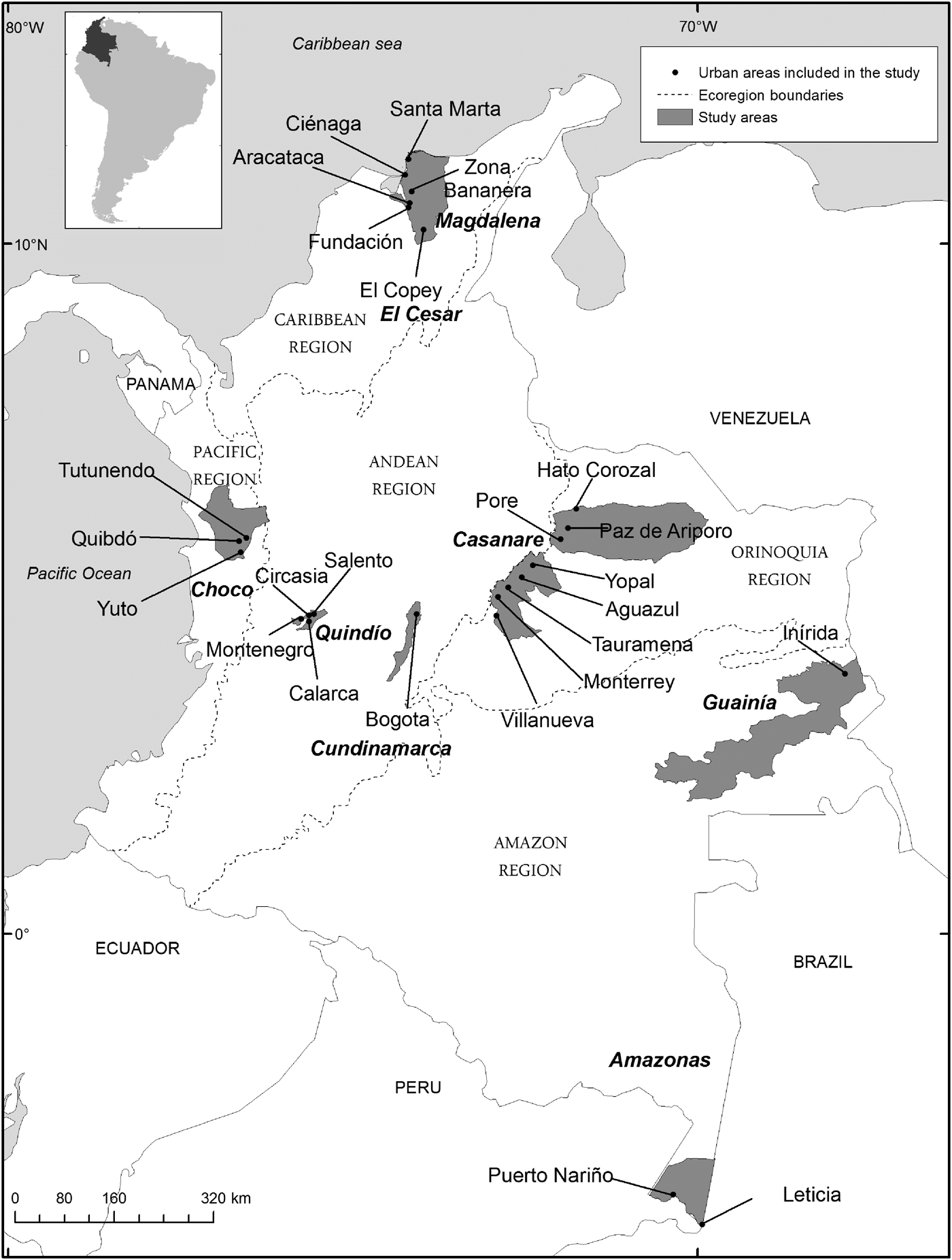
Fig. 1 Distribution of the study sites in five ecoregions of Colombia.
Table 1 The study areas in five ecoregions of Colombia (Fig. 1), with the main biomes represented, territorial environmental systems, river basins, human population, and area.
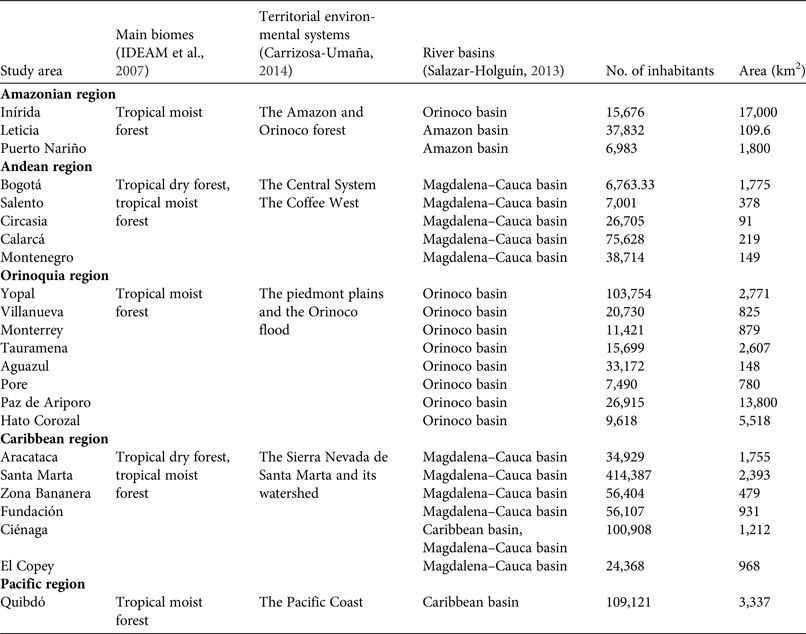
Colombia has a history of conflict, and some regions pose high risks for researchers, particularly in areas where illicit drug trafficking and illegal mining are carried out (PNUD, 2011). Security is therefore an important criterion in identifying appropriate locations for field research. Given that we were studying an illegal activity, we were particularly careful to avoid unnecessary risks for our research team.
Methods
The study was carried out in September 2013 in Leticia, and during November 2014–January 2015 at the other sites. We deployed three research teams, each comprising two people, who were trained to apply the methodology consistently. Each team conducted fieldwork in one or two ecoregions, spending 15–20 days at each site. We used a snowball strategy, asking the first person we contacted to provide us with names of other people in town selling bushmeat. We did this until no new contacts were referred to us. We visited a total of 528 sale points that might potentially sell bushmeat, including markets, restaurants, butcher shops, fish markets, food stalls and grocery stores (Table 2). We used participant observation, visited sale points and source areas regularly, and conducted informal discussions (in Spanish) with stakeholders. After the first visit and at an appropriate moment, to avoid mistrust, we explained the objectives of the study to stakeholders. Some stakeholders (3% of those approached) did not want to share information but most were interested in the motives of our research and contributed with interest to the study. We spent time discussing the use of wild meat with the various stakeholders, sometimes sharing a meal and conversing about their favourite meals. Conversations followed an unstructured format but were guided by questions such as: Is any bushmeat sold here? Do people here like it? Where does it come from? Who brings it here? How much control is there around here? What is the price of bushmeat? Which species are sold most often? Who buys the bushmeat? With the help of the stakeholders we mapped trade routes to estimate the catchment area offering meat to the town. We asked about the list of species sold at every site we visited.
Table 2 Places where bushmeat was sold in the urban and peri-urban areas visited, with number of places visited (and number of these with bushmeat on sale).
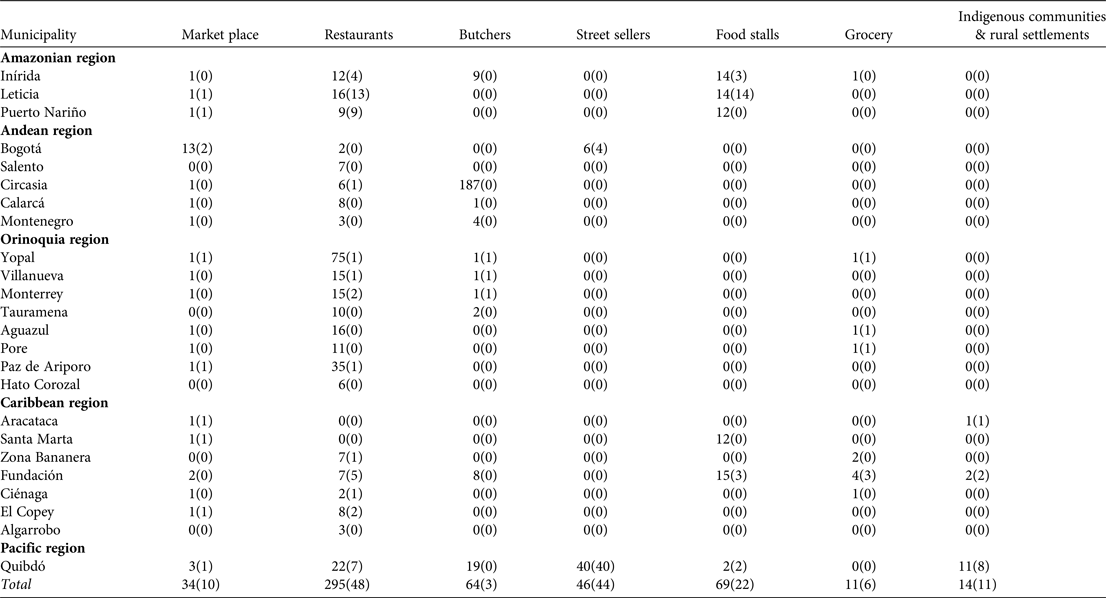
Results
Sale points and stakeholders Bushmeat was sold in all of the municipalities we visited. All sales detected were clandestine, hidden from the general public. Trade occurred within a trusted network of customers and sellers. A total of 139 of the 528 sale points visited traded wild meat (Table 2): 10 markets, 48 restaurants, three butchers, 44 non-food stalls, 22 food stalls, six grocery stores, and six sale points scattered within peri-urban areas. Women acted as intermediaries in the bushmeat trade, selling wild meat to complement their primary commercial activity (such as selling fish, domestic meats or groceries). Hunters sold their quarry directly to known consumers, took the meat to the local market, or disembarked it onto riverine harbours from where it was sold to urban restaurants or end consumers. Bushmeat was often kept hidden. A total of 193 hunters were known to participate in the market chain in the five ecoregions. Hunters supplying meat to towns were usually farmers of diverse origins (colonos, Afro-descendants or indigenous people) who hunted as part of a diversified economy on their own private lands or communal grounds. However, in the Pacific and Amazon regions we identified and interviewed peri-urban hunters who worked in rural (e.g. farming or timber extraction) and urban situations (e.g. transporters, carpenters) but relied on the bushmeat trade to supplement their income. For these people the sale of bushmeat was a highly lucrative activity, and some had the means to invest the equivalent of USD 1,200 in trained hunting dogs. Most hunters were men, although women and children also hunted small animals, such as rodents and birds, but only for their own consumption. The market chain is based on trust between hunters, intermediaries and consumers, who are in contact by phone or regular visits (Fig. 2), and trading usually occurs in the early morning, before dawn. Market chains have adapted to the level of law enforcement in each region.
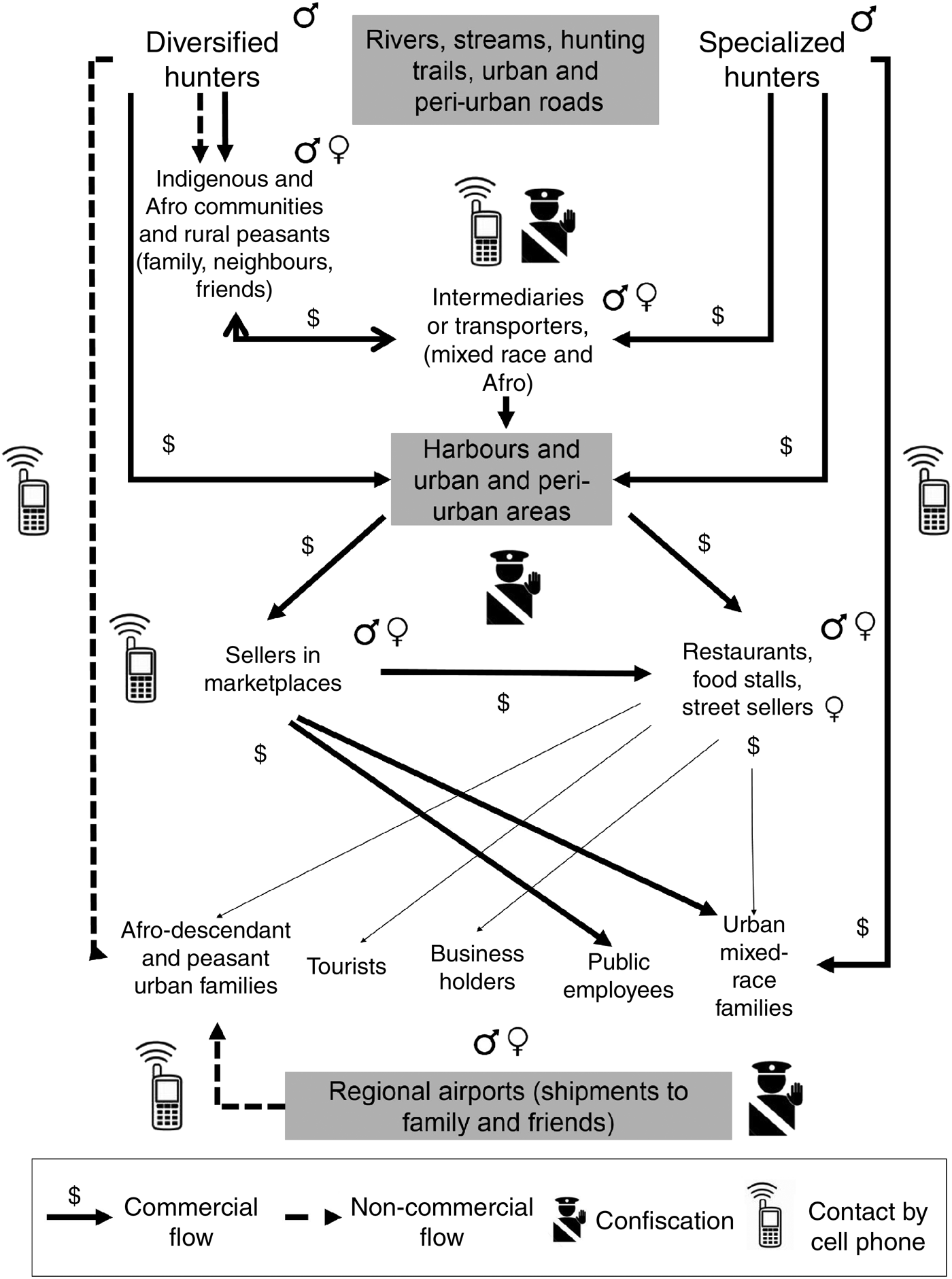
Fig. 2 The basic structure of the bushmeat commodity chain in Colombia.
Traded species In total, 85 species were traded in the five ecoregions studied (Supplementary Table S1). The proportion of each species sold at various locations is shown in Fig. 3. In the Amazon region 20 species were traded, and the most commonly traded species were the paca Cuniculus paca, grey brocket deer Mazama gouazoubira, red brocket deer Mazama americana, lowland tapir Tapirus terrestris and white-lipped peccary Tayassu pecari. In the Andean region 19 species were traded, most commonly the capybara, armadillo, pacarana Dinomys branickii, rabbit Sylvilagus brasiliensis and black agouti Dasyprocta fuliginosa. In Bogota, capybara, paca, armadillo, wild duck and pigeon were the most frequently traded species. In the Orinoquía region there was a distinct preference for capybara (dried or fresh); other commonly traded species included armadillo, paca and white-tailed deer Odocoileus virginianus. In the Caribbean region 14 species were reportedly traded, mainly paca, deer (red and grey brocket), black agouti and armadillo. In the Pacific region 28 species were traded, the most common being paca, followed by black agouti, armadillo, red and grey brocket deer, caiman and river turtles.
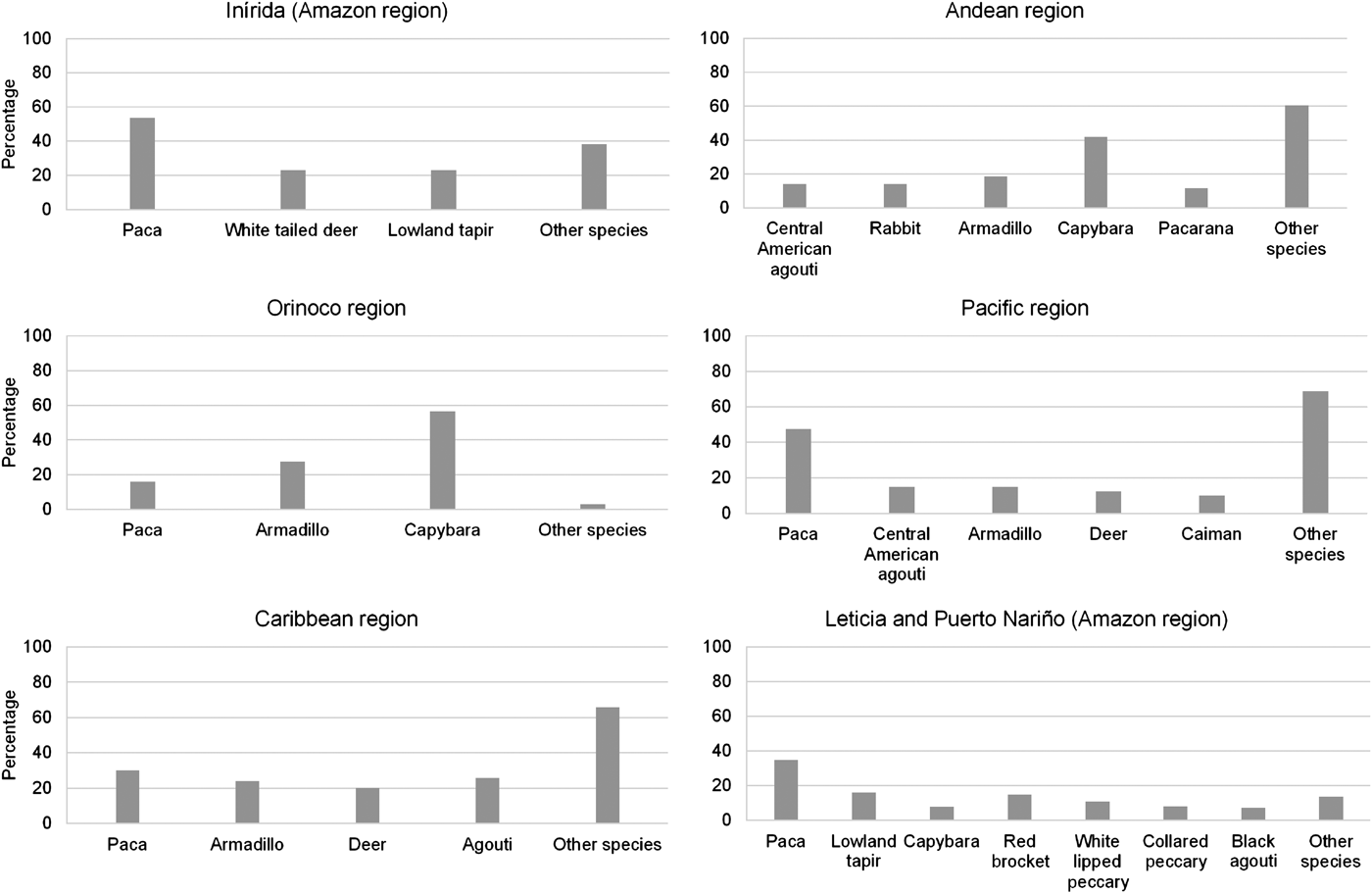
Fig. 3 Proportions of various species sold as bushmeat at six study sites within five ecoregions in Colombia (Fig. 1).
Trade routes In all regions except Bogota we observed short trade routes from rural areas to nearby towns. The distance between a town and its most remote source area was rarely > 150 km (c. 80 km in the Caribbean, usually < 90 km in the Amazon, and 100–150 km in the Orinoquía and Pacific regions). We observed no established longer routes towards the capital or to other countries, except for transboundary trade in the case of Leticia. Bogota is a special case, as bushmeat enters the city from remote places (from the Caribbean, Andean, Orinoquía or Amazon regions) but in small quantities and on a sporadic basis. Bushmeat is transported to the main urban centres via rivers and peri-urban and urban roads, using a variety of transport, including boats, motorcycles, bicycles, cars, public buses, mules and trucks.
Prices Bushmeat was the most expensive meat available in towns in the Caribbean, Pacific and Andean regions. In the Amazon, bushmeat was cheaper than beef but more expensive than most fish, chicken and canned meats. In the Orinoquía region bushmeat was less expensive than fish but more expensive than beef (Table 3). According to stakeholders' perceptions, prices depend on the availability of the resource, the intensity of law enforcement and the purchasing power of consumers. In rural and peri-urban areas around the study sites bushmeat was considered a cheap option as individuals hunted for their own consumption and occasional sale. However, in urban areas bushmeat is considered a luxury for which customers are willing to pay a premium price because of its special taste or as an alternative to beef, pork and chicken. In the Amazon, for example, beef costs USD 5 kg−1, industrial chicken USD 2.5 kg−1, and fresh bushmeat USD 4 kg−1 on average; in contrast, in the Andean and Pacific regions beef costs USD 4.7 kg−1 on average and fresh paca meat can retail for as much as USD 11.8 kg−1.
Table 3 Prices of bushmeat and other sources of animal protein (USD kg−1) in five ecoregions of Colombia (Fig. 1).

Discussion
We found evidence of bushmeat trade in towns in a range of ecoregions in Colombia. Despite regulations and law enforcement efforts bushmeat continues to be traded illegally by means of well-established, clandestine routes. This finding contrasts with the suggestion by Rushton et al. (Reference Rushton, Viscarra, Viscarra, Basset, Baptista and Brown2005) that bushmeat may no longer be consumed in urban areas in Latin America because of the availability of other cheaper sources of protein. Unlike bushmeat markets in Central Africa (Starkey, Reference Starkey2004; Fa et al., Reference Fa, Seymour, Dupain, Amin, Albrechtsen and Macdonald2006; Nasi et al., Reference Nasi, Taber and van Vliet2011; Dupain et al., Reference Dupain, Nackoney, Vargas, Johnson, Farfán, Bofaso and Fa2012; van Vliet et al., Reference van Vliet, Quiceno-Mesa, Cruz-Antia, Neves de Aquino, Moreno and Nasi2014) or some markets in the Brazilian Amazon (Baía et al., Reference Baía, Guimarães and Le Pendu2010; Parry et al., Reference Parry, Barlow and Pereira2014; van Vliet et al., Reference van Vliet, Cruz, Quiceno-Mesa, Neves de Aquino, Moreno, Ribeiro and Fa2015a) where bushmeat is sold openly, the trade in Colombia occurs clandestinely, although the stakeholders involved in the trade and the structure of the trade chain have similar characteristics to those observed in most Central and West African markets (Cowlishaw et al., Reference Cowlishaw, Mendelson and Rowcliffe2005). In Colombia, as in Central and West Africa, the main stakeholders in the trade chain are farmer hunters, commercial hunters, wholesalers, market traders and food stall operators. However, there are some differences: (1) In Colombia both men and women are involved in the trade, whereas in West and Central Africa the trade is conducted mainly by women. (2) In Colombia all traders have another primary occupation (they sell other food products, groceries or clothes, or have another source of income) and sell bushmeat to supplement their income. In Central and West Africa, market and food stall traders commonly specialize in bushmeat trade. (3) Most bushmeat is sold fresh or frozen in Colombia, whereas in West and Central African markets (except in Gabon) and in Brazil (van Vliet et al., Reference van Vliet, Cruz, Quiceno-Mesa, Neves de Aquino, Moreno, Ribeiro and Fa2015a) bushmeat is most often sold smoked (Cowlishaw et al., Reference Cowlishaw, Mendelson and Rowcliffe2005; van Vliet et al., Reference van Vliet, Quiceno-Mesa, Cruz-Antia, Neves de Aquino, Moreno and Nasi2014). (4) The number of stakeholders involved in the trade in Colombia is limited compared with Central Africa, and the trade occurs within a network of known consumers and a limited number of providers. In Leticia, for example, only two traders sell wild meat in the local market (van Vliet et al., Reference van Vliet, Cruz, Quiceno-Mesa, Neves de Aquino, Moreno, Ribeiro and Fa2015a), compared with a town such as Koulamoutou (Gabon), with a similar population size, which may have c. 13 traders operating in the market (Starkey, Reference Starkey2004). (5) In Bogota it is possible to find bushmeat but there is no organized regular market chain supplying the city, as observed in many cities in Central Africa. The trade remains concentrated in medium-sized towns close to source areas.
At our study sites, hunters come from rural or peri-urban areas and sell bushmeat as part of a diversified economy. Farmer hunters hunt for subsistence on private or community land, where they also practise agriculture and sell their surplus to known consumers or to wholesalers. Peri-urban hunters hunt mainly for commercial purposes but hunting is not their primary occupation. They often combine hunting and other rural livelihood activities (e.g. timber extraction) with small urban businesses or salaried jobs, as also observed in Brazil (van Vliet et al., Reference van Vliet, Cruz, Quiceno-Mesa, Neves de Aquino, Moreno, Ribeiro and Fa2015a). In urban areas in the Caribbean, Pacific and Andean regions, bushmeat is the most expensive type of meat available and the trade is lucrative, giving peri-urban hunters the means to invest in hunting for commercial purposes. As observed in some urban areas of Africa (Wilkie et al., Reference Wilkie, Starkey, Abernethy, Ntsame Effa, Telfer and Godoy2005; Fa et al., Reference Fa, Seymour, Dupain, Amin, Albrechtsen and Macdonald2006; Kümpel et al., Reference Kümpel, East, Keylock, Rowcliffe, Cowlishaw, Milner-Gulland, Davies and Brown2007; Brashares et al., Reference Brashares, Golden, Weinbaum, Barrett and Okello2011; van Vliet & Mbazza, Reference van Vliet and Mbazza2011; Bachand et al., Reference Bachand, Arsenault and Ravel2015; but also see some exceptions, e.g. van Vliet et al., Reference Quiceno, Cruz-Antia, Moreno, van Vliet, Trujillo and Duque2014), bushmeat is a luxury for wealthy families and is consumed despite being among the most expensive meats, whereas the opposite is true in more remote areas, where bushmeat continues to be among the cheapest available source of protein, provided there is a hunter in the family. In areas where bushmeat is less common (e.g. the Andean region) it can cost three times more than beef. As urban markets grow and rural areas are increasingly connected to them, it is possible that less bushmeat is kept for individual consumption and more is sold to the urban luxury market, which has implications for rural food security, as observed in Madagascar (Golden et al., Reference Golden, Fernald, Brashares, Rasolofoniaina and Kremen2011). In Brazil also, Parry et al. (Reference Parry, Barlow and Pereira2014) found evidence of a long-term transition from bushmeat as an economical source of protein for the poor to a luxury food for the wealthy.
The majority of species traded in Colombia are categorized as Least Concern on the IUCN Red List, and paca, black agouti, red and grey brocket deer, capybara and caiman are not categorized as threatened on Colombia's national Red List (IAvH, 2015). However, the white-lipped peccary is categorized as Vulnerable, the giant armadillo as Endangered, and the lowland tapir and white-tailed deer as Critically Endangered on the national Red List. Most of the markets in our study are therefore far from a post-depletion sustainability situation such as that observed in the Takoradi market in Ghana (Cowlishaw et al., Reference Cowlishaw, Mendelson and Rowcliffe2005), where only the more resilient species persist. For all our study sites, the trade of threatened species therefore warrants closer attention.
Bushmeat trade routes in Colombia are relatively short (≤ 150 km) and do not imply inter-regional or international trade (except for transboundary trade across border rivers in the Amazon). This is important for two reasons: (1) The possibility that the trade in bushmeat and the handling of fresh meat could contribute to the emergence of zoonotic pandemics, as observed in Africa, is limited. (2) The bushmeat trade involves a limited number of stakeholders operating in a small geographical area, which facilitates the development of programmes to target all levels of the trade (consumers, traders and hunters), with strategies that can be adapted to each of these levels, combining sensitization, legal sustainable trade, enforcement strategies and monitoring.
Acknowledgements
We thank all the stakeholders who agreed to participate in this research. We are grateful to the Instituto de Investigaciones Ambientales del Pacífico, the Instituto Alexander von Humboldt and Fundación Omacha for their support. This work was funded by USAID and UKAID through the Bushmeat Research Initiative of the Center for International Forestry Research.
Biographical sketches
Nathalie van Vliet's research focuses on the links between wildlife and livelihoods, and she has worked extensively on bushmeat and its role in food security and local economies in Central Africa and South America. Maria Quiceno's interests lie the management of biodiversity and conservation of natural resources by indigenous communities, farmers and settlers, and she has worked with research institutions and decision makers at national and international levels. Jessica Moreno is an environmental biologist specializing in participatory monitoring of use and trade of wildlife in the Amazonian trifrontier region and the Casanare department of Colombia. Daniel Cruz is an ecologist working on the use of biodiversity, wildlife management, socio-environmental conflicts and cultural change in rural communities. Julia Fa is a conservation scientist whose work focuses on human use of wildlife, threatened species and ex situ conservation. Robert Nasi's research interests include the sustainable use of forest products and the multiple-use management of tropical forests.








